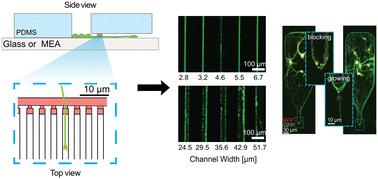Our official English website, www.x-mol.net, welcomes your
feedback! (Note: you will need to create a separate account there.)
Impact of microchannel width on axons for brain-on-chip applications
Lab on a Chip ( IF 6.1 ) Pub Date : 2024-10-23 , DOI: 10.1039/d4lc00440j Katarina Vulić, Giulia Amos, Tobias Ruff, Revan Kasm, Stephan J. Ihle, Joël Küchler, János Vörös, Sean Weaver
Lab on a Chip ( IF 6.1 ) Pub Date : 2024-10-23 , DOI: 10.1039/d4lc00440j Katarina Vulić, Giulia Amos, Tobias Ruff, Revan Kasm, Stephan J. Ihle, Joël Küchler, János Vörös, Sean Weaver

|
Technologies for axon guidance for in vitro disease models and bottom up investigations are increasingly being used in neuroscience research. One of the most prevalent patterning methods is using polydimethylsiloxane (PDMS) microstructures due to compatibility with microscopy and electrophysiology which enables systematic tracking of axon development with precision and efficiency. Previous investigations of these guidance platforms have noted axons tend to follow edges and avoid sharp turns; however, the specific impact of spatial constraints remains only partially explored. We investigated the influence of microchannel width beyond a constriction point, as well as the number of available microchannels, on axon growth dynamics. Further, by manipulating the size of micron/submicron-sized PDMS tunnels we investigated the space restriction that prevents growth cone penetration showing that restrictions smaller than 350 nm were sufficient to exclude axons. This research offers insights into the interplay of spatial constraints, axon development, and neural behavior. The findings are important for designing in vitro platforms and in vivo neural interfaces for both fundamental neuroscience and translational applications in rapidly evolving neural implant technologies.
中文翻译:

微通道宽度对脑芯片应用轴突的影响
用于体外疾病模型的轴突导向技术和自下而上的研究越来越多地用于神经科学研究。最流行的图案化方法之一是使用聚二甲基硅氧烷 (PDMS) 微结构,因为它与显微镜和电生理学兼容,能够精确有效地系统地跟踪轴突发育。以前对这些引导平台的调查指出,轴突倾向于跟随边缘并避免急转弯;但是,空间约束的具体影响仍仅进行了部分探讨。我们研究了超出收缩点的微通道宽度以及可用微通道的数量对轴突生长动力学的影响。此外,通过操纵微米/亚微米大小的 PDMS 隧道的大小,我们研究了阻止生长锥穿透的空间限制,表明小于 350 nm 的限制足以排除轴突。这项研究提供了对空间约束、轴突发育和神经行为相互作用的见解。这些发现对于设计体外平台和体内神经接口非常重要,这些平台和体内神经接口适用于快速发展的神经植入技术的基础神经科学和转化应用。
更新日期:2024-10-23
中文翻译:

微通道宽度对脑芯片应用轴突的影响
用于体外疾病模型的轴突导向技术和自下而上的研究越来越多地用于神经科学研究。最流行的图案化方法之一是使用聚二甲基硅氧烷 (PDMS) 微结构,因为它与显微镜和电生理学兼容,能够精确有效地系统地跟踪轴突发育。以前对这些引导平台的调查指出,轴突倾向于跟随边缘并避免急转弯;但是,空间约束的具体影响仍仅进行了部分探讨。我们研究了超出收缩点的微通道宽度以及可用微通道的数量对轴突生长动力学的影响。此外,通过操纵微米/亚微米大小的 PDMS 隧道的大小,我们研究了阻止生长锥穿透的空间限制,表明小于 350 nm 的限制足以排除轴突。这项研究提供了对空间约束、轴突发育和神经行为相互作用的见解。这些发现对于设计体外平台和体内神经接口非常重要,这些平台和体内神经接口适用于快速发展的神经植入技术的基础神经科学和转化应用。































 京公网安备 11010802027423号
京公网安备 11010802027423号